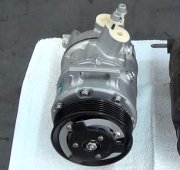R-12 went away in the early '90s. R-134 was the replacement and is widely available in do-it-yourself cans. The two are not compatible. If you retrofit an older system to use R-134, you must also remove the oil from the compressor and the system, then install new oil that's compatible with R-134.
The problem is it's impossible to know how much refrigerant is in a system, and it must be correct for it to work right. The only way to know is by recovering whatever is in there now, then pumping in a measured amount. The specified amount will result in the evaporator in the dash being half filled with liquid and half-filled with vapor. The point at which it turns from liquid to vapor is the point at which it gets very cold. If there's too little refrigerant in the system, that point of transition will be in the hose under the hood coming in from the condenser. If there's too much refrigerant, the point it turns cold will be in the hose going out under the hood to the compressor. You also run the risk of liquid sloshing into the compressor. At least that will lock it up causing the belt to squeal. At worst it can damage the compressor. This is one place where "more is not better".
For a long time Chrysler included a sight glass on top of the receiver / drier to show when the system is fully charged. If you use the little cans, keep adding with the system running as long as you see vapor bubbles flowing through that window. Stop adding as soon as those bubbles stop appearing.
(For Ford owners reading this, Ford used a sight glass too starting in the 1980s, but those must never be used. Even when fully-charged, there will still be bubbles in that sight glass. That can result in seriously overcharging the system. Those bubbles will never go away).
At this point the system is contaminated with two different non-compatible refrigerants. It needs to be recovered, but this is going to pose a problem. Most shops now use a refrigerant identifier to find anything that will contaminate their equipment. They still may be able to recover what's in there, but it will need to be sent to a specialist that will know what to do with it. The mechanic won't be able to separate them for recycling. Once the system is empty, they will put it under vacuum for at least 20 minutes. That will cause any water vapor to boil at 77 degrees and get drawn out. Most receiver / driers can absorb roughly ten droplets of water, but any water will promote corrosion, and as it circulates, it will freeze at the expansion valve. That will stop the flow of refrigerant until it melts, typically a half hour, then there will be flow again until that water comes back around. Pumping the system into a vacuum gets that water out, then the measured amount of refrigerant can be pumped back in.
Here's a link to an article that can explain this better than I can:
https://www.2carpros.com/articles/re-charge-an-air-conditioner-system
Thursday, May 4th, 2023 AT 7:22 PM


